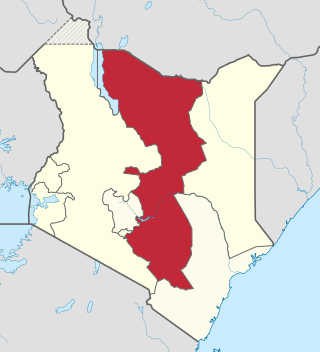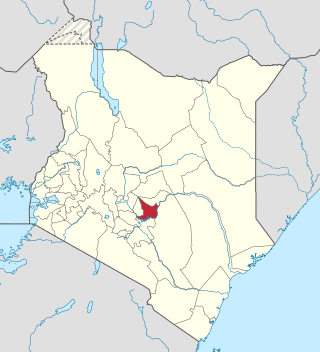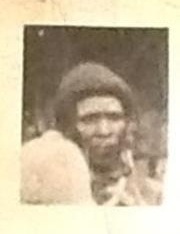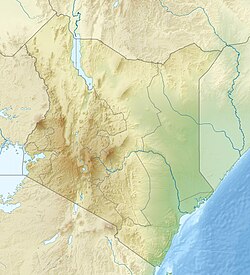
The Kamba or Akamba people are a Bantu ethnic group who predominantly live in Kenya stretching from Nairobi to Tsavo and northwards to Embu, in the southern part of the former Eastern Province. This land is called Ukambani and constitutes Makueni County, Kitui County and Machakos County. They also form the second largest ethnic group in 8 counties including Nairobi and Mombasa counties.

The Eastern Province of Kenya was one of 8 Provinces of Kenya. Its northern boundary ran along with that of Ethiopia; the North Eastern Province and Coast Province lay to the east and south; and the remainder of Kenya's provinces, including Central Province, ran along its western border. The provincial capital was Embu.

Mûkûûrî is an administrative Location and township in Runyenjes Division, in Embu County, Kenya, with a population of about 25,000 people. It is named for a large, strong Sycamore Fig Tree that stood for over 100 years at the current site of the township. The Sycamore Fig tree symbolizes strength, rejuvenation and regeneration. Mûkûû-rî region lies on the green, rolling hills of the Mount Kenya slopes. The administrative region begins from the stone cliffs of Nthûngû waterfalls, all the way to Nthenge Njerû falls, through the famous Kirimiri Forest, stretching to the historic Gogo Salt lick, bordering Gitare. It is home to four public primary schools, including Kubu Kubu Memorial Boarding School and Muragari School, which is among the oldest schools in Embu and Kîrînyaga districts.
Kubu Kubu, born as Njagi wa Ikutha,(1920-1956) was an Embu Mau Mau leader and general. His nom de guerre, Kubu Kubu, means "heavy thud" in Kîembu, referencing to the thud his feet made due to his heavy build.

Embu County is a county in the Republic of Kenya. The capital of Embu County and former Eastern province headquarters, Embu town, is a largely metropolitan area with a population of 608,599 persons. The county borders Kirinyaga to the west, Kitui to the east, Tharaka Nithi to the north and Machakos to the south. The county occupies an area of 2,821 km2. The county is home to the Aembu and Mbeere

Local authorities in Kenya are the bodies controlling local governance in urban areas in Kenya.

Mbeere District was a former administrative district in the Eastern Province of Kenya. Its capital town was Siakago. The district had a population of 170,950 and an area of 2,093 km2. The district was split from Embu District in 1996. In 2010, it was merged into Embu County.

The Embu or Aembu are a Bantu people indigenous to Embu county. The region is situated on the southern slopes of the former Eastern province. The Embu belong to the northeastern Bantu branch and speak the Embu language known as Kiembu as a mother tongue. It belongs to the Bantu branch of the Niger-Congo family. Kimeru, Kikuyu, and Kikamba share similar language characteristics. To the west, Embu neighbours are the closely related Kikuyu in Kirinyaga, Nyeri, Kiambu, Muranga and Nyandarua counties. The Meru people border the Embu to the East.
Siakago is a town in Embu County, Kenya. It was previously the capital of the former Mbeere District in Eastern Province. It hosted the Mbeere county council and was also headquarters of Siakago Division in Mbeere District. In 1999, Siakago Division had a population of 34,330, of whom 2,312 were classified urban Siakago is located 25 kilometres east of Embu town. The Kiangombe mountain lies just east of Siakago.
Mbeere North Constituency is an electoral constituency in Embu County, Kenya. It was formerly known as Siakago Constituency, one of two constituencies of the former Mbeere District. It has five wards, all of which elect MCAs for the county assembly.
Kangaru School, formerly known as Government African School Kangaru and Kangaru High School, is an all boys high school located in the Embu County, Kenya. It was built by the first missionaries that arrived in Kenya during the colonialism in the 1920s. It was rebuilt in 1947 by Sir Robin Wainright on a Harambee basis. It is one of the oldest schools in the country. There is a nearby village called Kangaru which is probably where the name comes from. There is a river close to the school, the Kapingazi River. The school is popularly referred to as Kangach.

The Mbeere or Ambeere people are a Bantu ethnic group inhabiting the former Mbeere District in the now-defunct Eastern Province of Kenya. According to the 2019 Kenya National census, there are 195,250 Mbeere who inhabit an area of 2,093 km2. They speak Kīmbeere language, a dialect of Embu, which is very similar to the languages spoken by their neighbours, the Kamba, Embu and Kikuyu.

Rũnyenje Wa Mũkobo was a "Paramount Chief" of the Embu people in Kenya in the early 20th century. Chief Runyenje was born in the Rũgusa area of the Embu district, near the present day location of the town of Rũnyenje's and its surrounding Runyenje's Constituency, which is named in honor of him.

Runyenjes is the second largest town in Embu County, Kenya. It is located about 150 km from Nairobi, and 75 km from Mount Kenya, at an altitude of 1500m.The population is estimated at 58,000 people, the majority of which are the Embu People who speak Kiembu, a Bantu language, as well as Kiswahili and English, the two official languages in Kenya. The area offers scenic views, with densely wooded hills, gentle valleys, flowing streams and rivers, waterfalls, as well as small-scale farms.
Peter Njeru Ndwiga is a Kenyan politician. He is the former Senator for Embu County and the chairman of the Agriculture and Livestock Committee of the Senate. He was minister for the Co-operative Development and Marketing in Kenya and a former member of parliament for the Manyatta Constituency and Runyenjes Constituency. He was member of parliament for the Manyatta Constituency which is now in Embu County on Party of National Unity ticket between 2002 and 2007. Prior to this, he was the member of parliament for Runyenjes Constituency between 1992 and 1997 and then the member of parliament for the newly created Manyatta Constituency between 1998 and 2001.
Embu District was an administrative district in the Eastern Province of Kenya. Its capital town is Embu. The district has a population of 278,196. The district was created by the colonial government as part of the divisions of the colony. Prior to independence, Kirinyaga District was carved out of Embu.

Martin Nyaga Wambora is a Kenyan politician. He is the first governor of Embu County in Kenya after winning on a TNA ticket in the Embu gubernatorial elections which was conducted in March 2013. He would later become the first Governor in Kenya to be impeached, not once but twice but he successfully challenged the impeachment later and was overwhelmingly Re-elected in 2017 winning his 2nd term in office. He was a former member of parliament for Runyenjes Constituency from 2003 to 2007. Prior to becoming the governor of Embu County, he served as the chairman of the board of Kenya Airports Authority and led to its winning of the two most prestigious airport industry awards in 2011.
University of Embu is a Kenyan chartered university. It transitioned from a constituent college to a full university on 7 October 2016.
Stanley Nyagah (1936–2005), nicknamed Kĩthũng'a, was a Kenyan educationist, civil servant, technocrat and, entrepreneur who, between 1983 -1988, served as Member of Parliament for Embu North constituency, now split into Runyenjes constituency and Manyatta constituency. His campaign symbol was a key (rũvungoro). The key symbolized the opening up of hitherto inaccessible public resources to the masses. While in parliament, he served on the public investments committee.
Meru Twin Towers, also Meru Church Towers, or Meru Destiny Towers, is a real estate development, planned in the town of Meru, the county seat of Meru County in the Eastern part of Kenya. The mixed use twin towers are owned by the developers, the Jesus House of Praise International Church.










